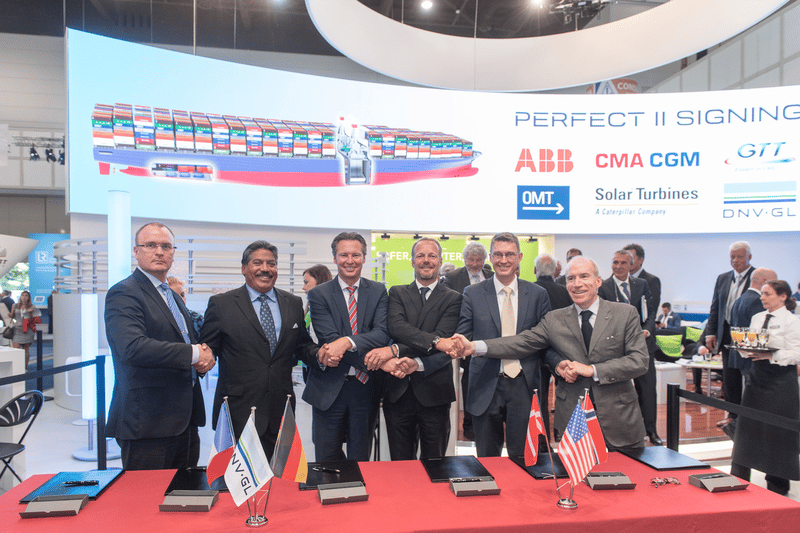Project partners GTT, CMA CGM (and its subsidiary CMA Ships) and DNV GL signed a cooperation agreement with new project participants ABB, the Caterpillar company Solar Turbines, and OMT for phase two of the highly successful PERFECt project.
The Piston Engine Room Free Efficient Containership project investigates the possibility of using a combined gas and steam turbine system (COGAS) to power an ultra large container vessel (ULCS). The first phase of the project performed by GTT, CMA Ships and DNV GL showed promising results with regard to the commercial competitiveness of the design compared to a LNG-fuelled ship with conventional propulsion system. The aim of the second phase of the project is to detail the technical concept and the commercial feasibility.
“CMA CGM and its subsidiary CMA Ships position themselves as pioneers by contributing to this worldwide leading innovation. We are glad to be part of the second phase of the PERFECt project, which aims at ensuring the best efficiency of this innovative vessel design,” says Ludovic Gérard, Executive Vice President CMA Ships. “The COGAS system with electrical propulsion gives us a great deal of freedom in the general arrangement and in tailoring the installed power to the real operational requirements we are facing. New partners will bring their expertise to go further than the initial concept,” he adds.
“GTT is pleased to collaborate with key technical and industrial players to develop the PERFECt project. The results of the first phase prove not only that the project is technically and economically viable, but also that the proven technologies can been deployed to make the PERFECt project a reality”, says Philippe Berterottière, Chairman and CEO of GTT.
“We are very excited to be part of the PERFECt project. ABB technology is already powering the first LNG-powered ice breaker and cruise ship, and we look forward to exploring its possibilities for container vessels,” says Juha Koskela, Managing Director of ABB’s Marine and Ports business.
“The PERFECt Ship consortium is unique in that it brings all parties together towards one common goal of efficient cargo transportation,” says Ennodio Ramos, Vice President, Power Generation and Strategic Growth of Solar Turbines Inc. (a Caterpillar Company). “In the future, LNG will play a major role as both a marine and low emissions fuel. Gas turbines burn LNG in a clean and efficient manner exceeding any current marine emission restrictions and provide a safe margin for future cleaner ships. Solar Turbines looks forward to participating in this consortium,” he adds. “Our customers are asking for solutions to improve vessel efficiency, drive down operating costs and maintain leading-edge up time,” Nigel Parkinson, Caterpillar Marine Managing Director, notes. “The expertise of our Caterpillar Marine experts from the Gas Technology Group out of Caterpillar Motoren GmbH & Co. KG, Kiel, and together with all project partners, Caterpillar Marine is prepared to offer solutions to our customers today to help them achieve this goal.”
In phase one of the project GTT, CMA CGM (and its subsidiary CMA Ships) and DNV GL released a technical and feasibility study for a COGAS-powered LNG-fuelled electrically driven mega box ship. Based on the results of that study, the PERFECt vessel design was found to offer potentially increased cargo capacity, greater layout flexibility and reduced maintenance costs than comparable conventionally powered HFO and LNG designs.

